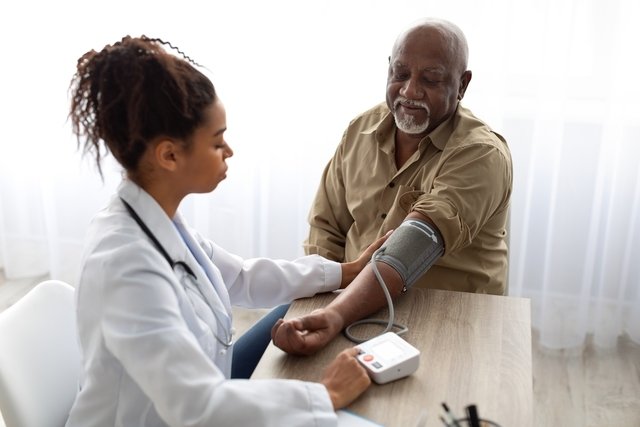The main symptoms of low blood pressure are dizziness, a feeling that the head is empty, a racing heart, nausea and/or vomiting, as well as mental confusion, excessive drowsiness or fainting, in the most serious cases.
Pressure is considered low when its value is less than 90×60 mmHg, or 9 by 6, and normally happens when it is very hot, the person gets up too quickly and/or drinks few fluids. Understand better what low blood pressure is and its causes.
Although low blood pressure is not always serious, in case of symptoms it is recommended to consult a cardiologist to check if there is a problem that requires treatment.

Main symptoms
The main symptoms of low blood pressure are:
1. Dizziness
Dizziness is a common symptom when blood pressure starts to drop and is usually accompanied by other symptoms such as nausea and/or vomiting. Dizziness happens due to changes in blood flow to parts of the brain that control balance. See other causes of dizziness and what to do.
2. Feeling empty-headed
When the pressure starts to drop, the person may feel empty or too light in the head, due to reduced oxygenation to the brain. Furthermore, it is also common to start having difficulty concentrating on your tasks.
3. Heart racing
When blood pressure is low, it is common to feel your heart racing, because the nervous system encourages it to pump more blood into the vessels in an attempt to normalize blood pressure. Learn about other causes of a racing heart.
4. Nausea and/or vomiting
Nausea and/or vomiting are symptoms that normally appear when low blood pressure begins to set in, indicating that the blood flow to parts of the brain such as the vestibular system, which helps control the body's balance, is reduced. Check out more causes of vomiting.
5. Weakness or tiredness
Due to low blood pressure, blood flow to the muscles can decrease, causing oxygen or nutrients to not reach them properly, causing symptoms such as weakness and tiredness.
6. Paleness
Paleness is a common symptom of low blood pressure and usually happens because, when the pressure drops, the more superficial blood vessels in the skin contract to encourage blood circulation in larger vessels in the body.
7. Difficulty concentrating
Difficulty concentrating may be an initial symptom of low blood pressure, indicating that areas of the brain responsible for attention and memory are not receiving enough oxygen to function properly.
8. Mental confusion
When blood pressure is very low, due to a lack of oxygen to the brain, the person can become confused, having difficulty reasoning and not recognizing where they are or the family members who are with them, for example.
9. I am excessive
Excessive sleep can sometimes indicate that blood pressure is too low and usually occurs due to changes in the functioning of the brain caused by reduced blood flow. In addition to being drowsy, the person may also be confused. Find out what excessive sleeping can be.
10. Fainting
Fainting usually happens when the pressure is excessively low and/or drops suddenly, meaning that not enough oxygen reaches the brain at that moment. Understand better what fainting is and its causes.
How to know if your pressure is low
To find out if your pressure is low, please enter your pressure data into the calculator below:
What to do
In case of symptoms of low blood pressure, it is recommended that the person stop what they are doing and sit or, if possible, lie down in a place where they can elevate their legs above heart level, to alleviate the symptoms.
Furthermore, if the symptoms are persistent, mental confusion or excessive drowsiness appears, or the person faints, it is recommended to seek emergency care. See more guidance on what to do in case of low blood pressure.
When low blood pressure causes symptoms, it is important to see a cardiologist for an evaluation. Make an appointment with the cardiologist closest to you:
Taking care of your health has never been easier!
Bibliography
- NAKATANI, Hitomi et al. Association between intraoperative hypotension and postoperative nausea and vomiting: a retrospective analysis of 247 thyroidectomy cases. Brazilian Journal of Anesthesiology. 2021
- AHA. Low Blood Pressure – When Blood Pressure Is Too Low. Disponível em: <https://www.heart.org/en/health-topics/high-blood-pressure/the-facts-about-high-blood-pressure/low-blood-pressure-when-blood-pressure-is-too-low>. Acesso em 17 ago 2023
- NIH. Low Blood Pressure. 2022. Available at: <https://www.nhlbi.nih.gov/health/low-blood-pressure>. Accessed on Aug 17, 2023
- HALL, John E. et al. Guyton & Hall Textbook of Medical Physiology. 13.ed. São Paulo – SP: Elsevier Editora Ltda, 2017.
- STATPEARLS. Shock. 2022. Available at: <https://www.ncbi.nlm.nih.gov/books/NBK531492/>. Accessed on Aug 17, 2023
- AHA. Syncope (Fainting). Disponível em: <https://www.heart.org/en/health-topics/arrhythmia/symptoms-diagnosis–monitoring-of-arrhythmia/syncope-fainting>. Acesso em 17 ago 2023
- PENN MEDICINE. Low Blood Pressure. Disponível em: <https://www.pennmedicine.org/for-patients-and-visitors/patient-information/conditions-treated-a-to-z/low-blood-pressure>. Acesso em 17 ago 2023
- STATPEARLS. Hypotension. 2023. Available at: <https://www.ncbi.nlm.nih.gov/books/NBK499961/>. Accessed on Aug 17, 2023
Re: “Blood pressure calculator”:
- FEITOSA, Audes Diogenes M.; BARROSO, Weimar KS; JUNIOR, Decio M. et al. Brazilian Guidelines for Blood Pressure Measurements Inside and Outside the Office – 2023. Arq. Bras. Cardiol. 4 ed. Vol 121; 2024




